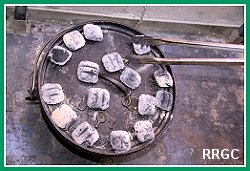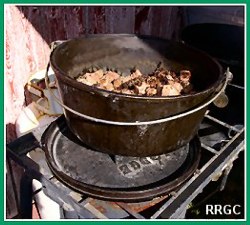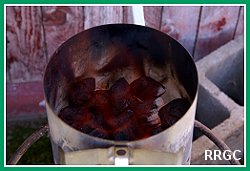Dutch Oven Cooking
Capt. Lewis
Wednesday April 30th 1806.
Drewyer killed a beaver and an otter; a pan of the former we reserved for ourselves and gave the indians the ballance. these people will not eat the dog but feast heartily on the otter which is vastly inferior in my estimation, they sometimes also eat their horses, this indeed is common to all the indians who possess this annimal in the plains of Columbia; but it is only done when necessity compells them.
*
The Dutch oven dates back to the 1600's and were widely used early colonist, pioneers and explorer such as Louis and Clark. A Dutch oven is a cast iron pot with a tight fit lid that can be used  for any type of cooking. The unique feature of a Dutch oven is its design which allows hot coals to be placed on top of the oven to have uniform heat on all sides of the pot. They are excellent for making roasts, stews, bread, cakes and other dishes. They can also be stacked on top of each other which conserves heat and allows multiple dishes to be prepared at the same time. The newer Dutch ovens are also made from aluminum and instead of hot coals, charcoal briquettes are used as the heat source. for any type of cooking. The unique feature of a Dutch oven is its design which allows hot coals to be placed on top of the oven to have uniform heat on all sides of the pot. They are excellent for making roasts, stews, bread, cakes and other dishes. They can also be stacked on top of each other which conserves heat and allows multiple dishes to be prepared at the same time. The newer Dutch ovens are also made from aluminum and instead of hot coals, charcoal briquettes are used as the heat source.
General Dutch Oven Information
 Anything that can be cooked in a home oven can be cooked in a Dutch Oven (DO). Anything that can be cooked in a home oven can be cooked in a Dutch Oven (DO). Temperature control is everything. Temperature control is everything. Protect your oven from the wind, it results in uneven heat distribution. Protect your oven from the wind, it results in uneven heat distribution.  Large diameter HVAC ducting works well; leave the seam open and just place around the DO. Large diameter HVAC ducting works well; leave the seam open and just place around the DO. General formula for initial heat using charcoal briquettes: Diameter of top of DO minus 3 briquettes on bottom and Diameter of DO plus 3 briquettes on top = approximately 325 degrees F. To increase 25 degrees F, add one briquette to both top and bottom. General formula for initial heat using charcoal briquettes: Diameter of top of DO minus 3 briquettes on bottom and Diameter of DO plus 3 briquettes on top = approximately 325 degrees F. To increase 25 degrees F, add one briquette to both top and bottom. Every time the DO lid is lifted, about 25 degrees F is lost; avoid removing the lid. Use your nose, if it smells done, it probably is. Every time the DO lid is lifted, about 25 degrees F is lost; avoid removing the lid. Use your nose, if it smells done, it probably is. It is easy to use too many briquettes-count. It is easy to use too many briquettes-count. When cooking over wood coals (campfire) it is difficult to burn anything. When cooking over wood coals (campfire) it is difficult to burn anything. If using an aluminum DO, be careful too much heat and the DO may melt; cooling breezes may serve like a bellows and do evil things. If using an aluminum DO, be careful too much heat and the DO may melt; cooling breezes may serve like a bellows and do evil things. To conserve on charcoal, stack one DO on top of another (Its safe up to about 3 or 4 high, after that things can get tricky.) To conserve on charcoal, stack one DO on top of another (Its safe up to about 3 or 4 high, after that things can get tricky.) Use some kind of base or fire pan, special Use some kind of base or fire pan, special  DO stands and discs from plows work well. If stacking DOs, the base will keep the legs from sinking into the ground and spilling the contents. DO stands and discs from plows work well. If stacking DOs, the base will keep the legs from sinking into the ground and spilling the contents. Stacked DOs (all but the top one) work like poorly sealed pressure cookers. Stacked DOs (all but the top one) work like poorly sealed pressure cookers. To preheat the oven, place several coals (4 to 8) on the lidded DO. If proofing bread, use 4-6 coals on the lid. To preheat the oven, place several coals (4 to 8) on the lidded DO. If proofing bread, use 4-6 coals on the lid. If using cast iron DO, be careful how it is washed. Use only very hot water on a well seasoned DO. Using soap or detergent will remove the seasoning. It may be necessary to re-season the DO periodically (some folks recommend annually). If using cast iron DO, be careful how it is washed. Use only very hot water on a well seasoned DO. Using soap or detergent will remove the seasoning. It may be necessary to re-season the DO periodically (some folks recommend annually). Use a plastic scraper to do initial cleaning after cooking. (The scrapers from Pampered Chef are excellent) Avoid using harsh abrasives as they can remove some of the seasoning. Use a plastic scraper to do initial cleaning after cooking. (The scrapers from Pampered Chef are excellent) Avoid using harsh abrasives as they can remove some of the seasoning. Spray the DO, and lid, with PAM or similar oil spray after cleaning, wipe off excess oil with a paper towel. Spray the DO, and lid, with PAM or similar oil spray after cleaning, wipe off excess oil with a paper towel. If you are storing your DO with the lid on, fold a paper towel and place it inside the oven with one end protruding outside. This will wick moisture away from the interior. If you are storing your DO with the lid on, fold a paper towel and place it inside the oven with one end protruding outside. This will wick moisture away from the interior. Avoid thermally shocking your DO (raise or lower the temperature gradually), too fast and you may crack your oven. Avoid thermally shocking your DO (raise or lower the temperature gradually), too fast and you may crack your oven. If cooking bread, spray PAM, or equal on bottom and sides of DO, then toss in some cornmeal and get it distributed. It makes the bread come out really easy. Or, you can use parchment paper; use the lid from the next smaller size DO to cut a round. If cooking bread, spray PAM, or equal on bottom and sides of DO, then toss in some cornmeal and get it distributed. It makes the bread come out really easy. Or, you can use parchment paper; use the lid from the next smaller size DO to cut a round. If you want to make ice cream, use 2 nested DOs, ice and salt in the outer, custard in the inner. It works! Just be sure to rinse the outer DO really well to remove any remnant salt. If you want to make ice cream, use 2 nested DOs, ice and salt in the outer, custard in the inner. It works! Just be sure to rinse the outer DO really well to remove any remnant salt.
Dutch Oven Accessories
 A lid lifter (essential) A lid lifter (essential)  Tongs, to add or remove coals (essential) Tongs, to add or remove coals (essential) Leather welding gloves (handy) Leather welding gloves (handy) Whisk broom, to remove ashes (handy) Whisk broom, to remove ashes (handy) Charcoal chimney (handy for getting coals going faster) Charcoal chimney (handy for getting coals going faster) Fire pan or DO stand (ranges from handy to essential) Fire pan or DO stand (ranges from handy to essential) Small fireplace, ash shovel (handy for cleaning up the DO stand) Small fireplace, ash shovel (handy for cleaning up the DO stand) Wind break (ranges from nice to essential) Wind break (ranges from nice to essential) Meat thermometer (important) Meat thermometer (important) Trivet (very handy) Trivet (very handy)
|
|
 for any type of cooking. The unique feature of a Dutch oven is its design which allows hot coals to be placed on top of the oven to have uniform heat on all sides of the pot. They are excellent for making roasts, stews, bread, cakes and other dishes. They can also be stacked on top of each other which conserves heat and allows multiple dishes to be prepared at the same time. The newer Dutch ovens are also made from aluminum and instead of hot coals, charcoal briquettes are used as the heat source.
for any type of cooking. The unique feature of a Dutch oven is its design which allows hot coals to be placed on top of the oven to have uniform heat on all sides of the pot. They are excellent for making roasts, stews, bread, cakes and other dishes. They can also be stacked on top of each other which conserves heat and allows multiple dishes to be prepared at the same time. The newer Dutch ovens are also made from aluminum and instead of hot coals, charcoal briquettes are used as the heat source. DO stands and discs from plows work well. If stacking DOs, the base will keep the legs from sinking into the ground and spilling the contents.
DO stands and discs from plows work well. If stacking DOs, the base will keep the legs from sinking into the ground and spilling the contents.